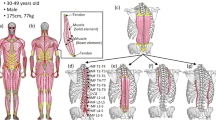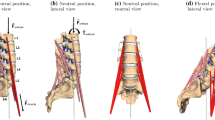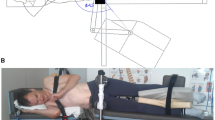Abstract
This work aimed to evaluate trunk muscle forces, internal loads and stability margin under some simulated standing postures, with and without external loads, using a nonlinear finite element model of the T1–S1 spine with realistic nonlinear load-displacement properties. A novel kinematics-based algorithm was applied that exploited a set of spinal sagittal rotations, initially calculated to minimize balancing moments, to solve the redundant active–passive system. The loads consisted of upper body gravity distributed along the spine with or without 200 N held in the hands, either in the front of the body or on the sides. Nonlinear and linear stability/perturbation analyses at deformed, stressed configurations with a linear stiffness-force relationship for muscles identified the system stability and critical muscle stiffness coefficient. Predictions were in good agreement with reported measurements of posture, muscle EMG and intradiscal pressure. Minimal changes in posture (posterior pelvic tilt and lumbar flattening) substantially influenced muscle forces, internal loads and stability margin. Addition of 200 N load in front of the body markedly increased the system stability, global muscle forces, and internal loads, which reached anterior shear and compression forces of ~500 N and ~1,200 N, respectively, at lower lumbar levels. Co-activation in abdominal muscles (up to 3% maximum force) substantially increased extensor muscle forces, internal loads and stability margin, allowing a smaller critical muscle coefficient. A tradeoff existed between lower internal loads in passive tissues and higher stability margins, as both increased with greater muscle activation. The strength of the proposed model is in accounting for the synergy by simultaneous consideration of passive structure and muscle forces under applied postures and loads.




Similar content being viewed by others
References
Aspden RM (1989) The spine as an arch—A new mathematical model. Spine 14:276–284
Bergmark A (1989) Stability of the lumbar spine—A study in mechanical engineering. Acta Orthop Scand Suppl 230:1–54
Bogduk N, Macintosh JE, Pearcy MJ (1992) A universal model of the lumbar back muscles in the upright position. Spine 17:897–913
Cholewicki J, McGill SM (1995) Relationship between muscle force and stiffness in the whole mammalian muscle: A simulation study. J Biomech Eng 117:339–342
Cholewicki J, McGill SM (1996) Mechanical stability of the in vivo lumbar spine: Implications for injury and chronic low back pain. Clin Biomech (Bristol, Avon) 11:1–15
Cholewicki J, VanVliet JJ (2002) Relative contribution of trunk muscles to the stability of the lumbar spine during isometric exertions. Clin Biomech (Bristol, Avon) 17:99–105
Cholewicki J, Panjabi MM, Khachatryan A (1997) Stabilizing function of trunk flexor-extensor muscles around a neutral spine posture. Spine 22:2207–2212
Cholewicki J, Juluru K, McGill SM (1999) Intra-abdominal pressure mechanism for stabilizing the lumbar spine. J Biomech 25:17–28
Cholewicki J, Simons APD, Radebold A (2000) Effects of external trunk loads on lumbar spine stability. J Biomech 33:1377–1385
Crisco JJ 3rd, Panjabi MM (1991) The intersegmental and multisegmental muscles of the lumbar spine—A biomechanical model comparing lateral stabilizing potential. Spine 16:793–799
Dumas GA, Poulin MJ, Roy B, Gagnon M, Jovanovic M (1991) Orientation and moment arms of some trunk muscles. Spine 16:293–303
Gagnon D, Larivière C, Loisel P (2001) Comparative ability of EMG, optimisation, and hybrid modelling approaches to predict trunk muscle forces and lumbar spine loading during dynamic sagittal plane lifting. Clin Biomech (Bristol, Avon) 16:359–372
Gardner-Morse M, Stokes IAF (1998) The effects of abdominal muscle coactivation on lumbar spine stability. Spine 23:86–92
Gardner-Morse M, Stokes IAF, Laible JP (1995) Role of muscles in lumbar spine stability in maximum extension efforts. J Orthop Res 13:802–808
Granata KP, Marras WS (1995) An EMG-assisted model of trunk loading during free-dynamic lifting. J Biomech 28:1309–1317
Granata KP, Orishimo KF (2001) Response of trunk muscle coactivation to changes in spinal stability. J Biomech 34:1117–1123
Han JS, Ahn JY, Goel VK, Takeuchi R, McGowan D (1997) CT-based geometric data of human spine musculature, Part 1. Japanese patients with chronic low back pain. J Spinal Disord 5:448–458
Holm S, Indahl A, Solomonow M (2002) Sensorimotor control of the spine. J Electromyogr Kinesiol 12:219–234
Hughes RE, Chaffin DB, Lavender SA, Andersson GBJ (1994) Evaluation of muscle force prediction models of the lumbar trunk using surface electromyography. J Orthop Res 12:689–698
Kiefer A, Shirazi-Adl A, Parnianpour M (1996) Creep stability of human spine in neutral postures. In: Engin AE (ed) Proceedings of the Engineering Systems Design and Analysis Conference. 77:27–34
Kiefer A, Shirazi-Adl A, Parnianpour M (1997) On the stability of human spine in neutral postures. Eur Spine J 6:45–53
Kiefer A, Shirazi-Adl A, Parnianpour M (1998) Synergy of human spine in neutral postures. Eur Spine J 7:471–479
Lucas DB, Bresler B (1961) Stability of the ligamentous spine. Biomechanics Laboratory, University of California at Berkeley, pp 1–41
Marras WS, Jorgensen MJ, Granata KP, Wiand B (2001) Female and male trunk geometry: Size and prediction of the spine loading trunk muscles derived from MRI. Clin Biomech (Bristol, Avon) 16:38–46
McGill SM, Patt N, Norman RW (1988) Measurement of the trunk musculature of active males using CT scan radiography: Implications for force and moment generating capacity about the L4/L5 joint. J Biomech 21:329–341
Nachemson A (1981) Disc pressure measurements. Spine 6:93–97
Oxland T, Lin RM, Panjabi M (1992) Three-dimensional mechanical properties of the thoracolumbar junction. J Orthop Res 10:573-580
Panjabi M, Yamamoto I, Oxland T, Crisco J (1989) How does posture affect coupling in the lumbar spine? Spine 14:1002–1011
Parnianpour M, Shirazi-Adl A, Hemami H et al (1994) The effect of compressive load on the myoelectric activities of ten selected trunk muscles. In: Proceedings of the 12th Triennial Congress of the International Ergonomics Association, 3:119–121
Patwardhan A, Havey RM, Meade KP, Lee B, Dunlap B (1999) A follower load increases the load-carrying capacity of the lumbar spine in compression. Spine 24:1003–1009
Pearsall DJ (1994) Segmental inertial properties of the human trunk as determined from computed tomography and magnetic resonance imagery. PhD thesis, Queen’s University, Kingston, Ontario
Pop DG (2001) Analyse non linéaire par éléments finis du système actif passif de la colonne vertébrale humaine. Dissertation, Génie mécanique, École Polytechnique, Montréal, Québec
Potvin JR, O’Brien PR (1998) Trunk muscle co-contraction increases during fatiguing, isometric, lateral bend exertions. Possible implications for spine stability. Spine 23:774–780
Raikova RT, Prilutsky BI (2002) Sensitivity of predicted muscle forces to parameters of the optimization-based human leg model revealed by analytical and numerical analyses. J Biomech 34:1243–1255
Reid JG, Livingston LA, Pearsall DJ (1994) The geometry of the psoas muscle as determined by magnetic resonance imaging. Arch Phys Med Rehabil 75:703–708
Rohlmann A, Arntz U, Graichen F, Bergmann G (2001) Loads on an internal spinal fixation device during sitting. J Biomech 34:989–993
Rohlmann A, Graichen F, Bergmann G (2002) Loads on an internal spinal fixation device during physical therapy. Phys Ther 82:44–52
Sadouk S (1998) Analyse mécanique par éléments finis du système actif-passif de la colonne lombaire humaine. Dissertation, Génie mécanique, École Polytechnique, Montréal, Québec
Sahdmehr R, Arbib MA (1992) A mathematical analysis of the force-stiffness characteristics of muscles in control of a single joint system. Biol Cybern 66:463–477
Shirazi-Adl A, Drouin G (1988) Nonlinear gross response analysis of a lumbar motion segment in combined sagittal loadings. J Biomech Eng 110:216-222
Shirazi-Adl A, Parnianpour M (1993) Nonlinear response analysis of the human ligamentous lumbar spine in compression: On mechanisms affecting the postural stability. Spine 18:147-158
Shirazi-Adl A, Parnianpour M (1996) Role of posture in mechanics of the lumbar spine in compression. J Spinal Disord 9:277–286
Shirazi-Adl A, Parnianpour M (1996) Stabilizing role of moments and pelvic rotation on the human spine in compression. J Biomech Eng 118:26–31
Shirazi-Adl A, Parnianpour M (1999) Effect of changes in lordosis on mechanics of the lumbar spine—lumbar curvature in lifting. J Spinal Disord 12:436–447
Shirazi-Adl A, Parnianpour M (1999) Pelvic tilt and lordosis control spinal postural response in compression. In: Transactions of the Orthopaedic Research Society, Anaheim, CA, p 1012
Shirazi-Adl A, Parnianpour M (2000) Load-bearing and stress analysis of the human spine under a novel wrapping compression loading. Clin Biomech (Bristol, Avon) 15:718–725
Shirazi-Adl A, Ahmed AM, Shrivastava SC (1986) Mechanical response of a lumbar motion segment in axial torque alone and combined with compression. Spine 11:914–927
Shirazi-Adl A, Ahmed AM, Shrivastava SC (1986) A finite element study of a lumbar motion segment subjected to pure sagittal plane moments. J Biomech 19:331-350
Shirazi-Adl A, Sadouk S, Parnianpour M, Pop D, El-Rich M (2002) Muscle force evaluation and the role of posture in human lumbar spine under compression. Eur Spine J 11:519–526
Solomonow M, Zhou BH, Harris M, Lu Y, Baratta RV (1998) The ligamento-muscular stabilizing system of the spine. Spine 23:2552–2562
Solomonow M, Zhou BH, Baratta RV, Lu Y, Harris M (1999) Biomechanics of increased exposure to lumbar injury caused by cyclic loading: Part 1. Loss of reflexive muscular stabilization. Spine 24:2426–2434
Stokes IA, Gardner-Morse M (1995) Lumbar spine maximum efforts and muscle recruitment patterns predicted by a model with multijoint muscles and joints with stiffness. J Biomech 28:173–186
Stokes IA, Gardner-Morse M (1998) Quantitative anatomy of the lumbar musculature. J Biomech 32:311–316
Stokes IA, Gardner-Morse M (2001) Lumbar spinal muscle activation synergies predicted by multi-criteria cost function. J Biomech 34:733–740
Wilke HJ, Wolf S, Claes LE, Arand M, Wiesend A (1995) Stability increase of the lumbar spine with different muscle groups. Spine 20:192–198
Wilke HJ, Neef P, Caimi M, Hoogland T, Claes LE (1999) New in vivo measurements of pressures in the intervertebral disc in daily life. Spine 24:755–763
Yamamoto I, Panjabi M, Crisco T, Oxland T (1989) Three-dimensional movements of the whole lumbar spine and lumbosacral joint. Spine 14:1256–1260
Acknowledgements
This work is supported by grants from the Institut de recherche en santé et en sécurité du travail du Québec (IRSST-Québec) and the Natural Sciences and Engineering Research Council of Canada (NSERC-Canada). The assistance of N. Arjmand in development of optimization routines is gratefully appreciated.
Author information
Authors and Affiliations
Corresponding author
Rights and permissions
About this article
Cite this article
Shirazi-Adl, A., El-Rich, M., Pop, D.G. et al. Spinal muscle forces, internal loads and stability in standing under various postures and loads—application of kinematics-based algorithm. Eur Spine J 14, 381–392 (2005). https://doi.org/10.1007/s00586-004-0779-0
Received:
Revised:
Accepted:
Published:
Issue Date:
DOI: https://doi.org/10.1007/s00586-004-0779-0




